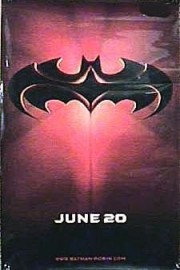Batman Forever
It’s been about 20 years since I’d seen Joel Schumacher’s first Batman film, and the third in the initial series Warner Bros. started with Tim Burton in 1989. At the time, the two biggest things that stood out for me were Jim Carrey’s performance as The Riddler and the circus-like production design, the latter of which took the look of the franchise in a 180-degree direction from where Burton went in his 1989 film and his 1992 sequel, “Batman Returns.” Seeing it again, my feelings about aren’t so tunnel vision. I still prefer Burton’s films, and Michael Keaton’s work as Bruce Wayne/Batman, but the more family-friendly approach of Schumacher in this film cannot be so easily dismissed. (“Batman & Robin” is another matter, and will be dealt with next year.)
In this film, we begin with a bank heist being carried out by Harvey “Two-Face” Dent, played here by Tommy Lee Jones, who was Schumacher’s top choice despite already having Billy Dee Williams (who played him in the original Burton film) contractually lined up for the role. The make-up on Two-Face by Rick Baker signals the garish absurdity of Schumacher’s vision here- color, color, color, the bolder, the better. Batman, as he is wont to do, shows up and foils his plan, but not before his first meeting with Dr. Chase Meridian (Nicole Kidman), a psychiatrist working with Gotham PD. The banter is strong with them, and Dr. Meridian is immediately taken by him…in a strictly professional manner, of course. His alter ego, Bruce Wayne (Val Kilmer), has other matters to attend to, as he goes to his science division and is introduced to Dr. Edward Nigma (Carrey) and his bold idea for a new level of interactive television. Wayne sees the danger in such a device, however, and squashes Edward’s ideas, and in the process, creates another villain for himself to fight. Meanwhile, he is haunted by the death of his parents, and his memories of the event are starting to come back to the moment when his fear of bats manifested. They will be further aggravated when he is asked to take in Dick Grayson (Chris O’Donnel), whose family was killed by Two-Face at a charity circus Wayne attended. Their connection will grow when Grayson discovers the secret of who Bruce Wayne really is.
There’s a lot to unpack in that story summary, but one of the things that struck me watching it again was how connected everything was on a thematic level. “Batman Forever” is seen by most as the beginning of the end of the original Batman film series, and from a tone level, the production design certainly points at the campiness that would hit overdrive in “Batman & Robin,” but the script by Lee & Janet Scott Batchler and Akiva Goldsman is well-attuned to looking at the duel psychology of Bruce Wayne in a way that I think a lot of people, including myself, had forgotten about over the years, and outright ignored in 1995. That isn’t to say that it’s as sophisticated in it’s approach as Christopher Nolan’s “Dark Knight” trilogy a decade later, but it’s definitely in keeping with the basic narrative thrusts of the Burton films as seeing the villains as reflections of Bruce Wayne. Replacing Keaton in the title role was Val Kilmer, and while there’s a different energy to his Bruce Wayne than Keaton’s, it’s compelling in it’s own right, especially in his scenes with Kidman (who has never looked more voluptuous) and O’Donnel, who looks too old to be an orphan of no means that must be taken in by Bruce Wayne, but still has some nice moments in the role. (I can see why Bob Kane, Batman’s co-creator, said at the time that Kilmer felt like the closest to his vision of Wayne of anyone who had played the role at the time.)
On the villain’s side, the film is very much a mixed bag. It’s hard to imagine a more embarrassing role in Tommy Lee Jones’s career than his over-the-top craziness as Harvey Dent- this is a miscalculation that haunts the film almost as much as his parent’s death haunts Bruce Wayne. I really don’t know why Schumacher, or anyone, thought Jones (best in more subdued roles) trying to be a theatrical villain would be a good idea, especially with half his face in pink make-up and his clothes decked out like a pimp’s. His performance was ridiculous then, and it is ridiculous now, and not just because Nolan seemed to better serve the character in “The Dark Knight,” even if Two-Face didn’t show up until the end. The star of the film, then and now, is Carrey as The Riddler. Not long after his breakthrough with “Ace Ventura: Pet Detective,” “The Mask” and “Dumb & Dumber,” he was paid big money to play The Riddler in this film and he earns every penny. Yes, he goes from manic to crazy throughout the span of the movie, but he’s also given as strong a character arc as any Batman villain was given between 1989-97, and he plays right into it beautifully. This was one of Carrey’s key performances that showed he could bring some shade into a character, regardless of how big he plays it, and it’s still one of my favorite performances of his.
“Batman Forever” held up surprisingly well after 20 years. I still wouldn’t trade Nolan’s and Burton’s films for anything, and I like what Ben Affleck and Zack Snyder have going on with this new Batman, but the campy visual style aside, Schumacher did well with the franchise Warner Bros. handed him the first time out. I don’t expect to be as accepting of the second film Schumacher directed in the series the next time I see that one.










